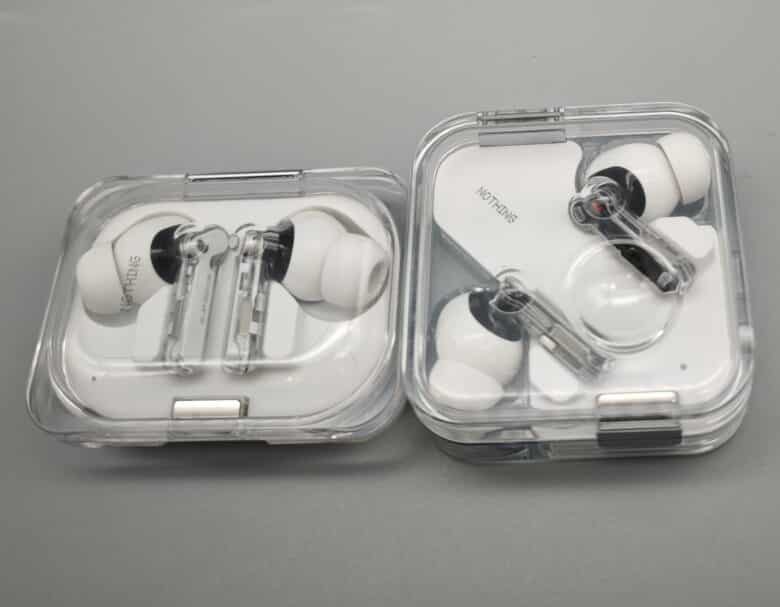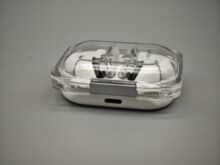
Having already reviewed the 150 euro Nothing Ear, the Nothing Ear (a) now follow. The entry-level model starts at an extremely attractive price of just 99 euros and scored highly in our test with a great sound, good active noise suppression and impressive features.
Technical data
| The product | Nothing Ear (a) |
| Bluetooth version | 5.3 |
| Bluetooth codecs | AAC, SBC, LDAC |
| Maximum operating range | 12m (without obstacle) |
| Battery life |
|
| Charging time | 1.5 hours (for charging case via USB-C or wireless) 10 minutes for 10 hours of playback |
| Size of charging case (H x W x D) | 47.6 mm x 63.3 mm x 22.7 mm |
| Weight | 4.8 g per earbud; 39.6 g charging case & earphones |
| Most important functions | ANC; transparency mode; wear detection; multipoint, gaming mode, ChatGPT |
| Price | € 94.99 * |
Nothing Ear (a) Review: chic design meets impeccable workmanship
- timeless, convincing design
- impeccable workmanship
- handy charging case
Unsurprisingly, the Nothing Ear (a) have the same transparent design as the manufacturer’s other in-ear headphones. The appearance, size and design accents are almost identical to the Nothing Ear, with the difference that the more affordable entry-level model is available in a bright yellow in addition to the classic black and white colors.
The white version of our test sample only differs visually from the Nothing Ear in one respect, as the corrugated style is also available in white, while the more expensive Ear in black provides a nice accent.
This makes the Nothing Ear (a) look a little “cleaner” and even more minimalist. The manufacturer’s excellent and still unique design is also extremely appealing here and makes quite a visual impact.
Another design difference: the body of the Ear (a) has a matt white finish, while the Nothing Ear has a glossy finish. However, this does not make any difference.
The excellent workmanship is also on a par with its more expensive sibling. However, there are differences in the charging case. This is because the Ear (a) case is much more compact and lighter in direct comparison, but has become somewhat chunkier in terms of shape and is not quite as easy to open.
With its handy dimensions of 47.6 mm x 63.3 mm x 22.7 mm, the Ear (a) Case fits even better in your pocket, but you have to do without a wireless charging function. Charging is exclusively via USB-C.
In addition, the Ear (a) case only has IPX2 certification against dripping water, while the Ear is also protected against rain and moisture with IP55. The earbuds themselves, on the other hand, are also protected against splashing water in accordance with IP54.
Outstanding wearing comfort
- 4.8 Gamm per earbud
- excellent wearing comfort
With a weight of 4.8 grams per earbud, the Nothing Ear (a) are slightly heavier than the Ear, but otherwise have the same shape. Accordingly, the cheaper model also offers excellent wearing comfort, thanks to which the in-ear headphones rest comfortably in the ears for hours without pinching.
A total of three sizes of silicone ear tips are included in the scope of delivery, with size M already pre-installed. With sizes S and L, however, everyone should be able to find the perfect fit. And even if the Nothing Ear (a) are not the lightest in-ear headphones, it is the convincing shape of the body that makes them one of the most comfortable models on the market.
Impressive features at an affordable price
- Bluetooth 5.3
- high-resolution LDAC codec
- Multipoint, wearer detection and gaming mode
While you usually have to compromise on features in the price segment up to 100 euros, Nothing equips the Ear (a) with a convincing feature set. Like the Ear, they rely on modern Bluetooth 5.3, which scores with a long range.
The in-ears also have the high-resolution LDAC codec, which significantly improves the audio quality when used with a suitable player. However, the LHDC 5.0 codec is reserved for the more expensive Nothing Ear.
The Nothing Ear (a) also feature active noise cancellation including transparency mode, a dedicated gaming mode with particularly low latency, as well as wearer detection including mono mode.
Thanks to Bluetooth multipoint, they can also be paired with two audio sources simultaneously, which in turn is particularly fast thanks to Google Fast Pair and Microsoft Swift Pair in the Android and Windows ecosystem.
Precisely customizable operation and good battery life
- precise touch control
- up to 5.5 hours runtime
- 42.5 hours runtime with charging case
The operating concept of the Nothing Ear (a) is also impressive. The in-ear headphones rely on precise touch control, which is triggered by pressing the sensor surface together rather than touching it.
This is located on the outside of the styles in silver, easily accessible and works perfectly and quickly. Pressing once starts or pauses playback, pressing twice skips to the next song, pressing three times skips to the previous song.
A volume control can also be added within the companion app, which increases or decreases the volume by pressing twice and holding down. I think the operating concept is very successful, as pressing together offers more precision than some of the competition’s touch controls.
I was also pleasantly surprised by the battery life of the Nothing Ear (a), which is even better than that of the Nothing Ear. With up to 5.5 hours of runtime including active noise suppression, this is at a good level, although some competitors achieve significantly more. The Cambridge Audio Melomania M100 (our test), for example, offer almost double that with 10 hours – but at twice the price.

With the charging case, the Ear (a) have a total runtime of 42.5 hours, so you can easily get through long days. The charging time of around two hours is fine, but charging is only possible via USB-C.
Very good sound from the Nothing Ear (a)
- 11 mm drivers
- pleasing, detailed and clear sound image…
- … but not as neutral and airy as the Ear
Nothing equips the Ear (a) with dynamic 11 mm drivers, which are just as large as the manufacturer’s more expensive models, but are made of PMI and TPU rather than ceramic. This makes for an audibly different, but by no means inferior, sound image compared to the Nothing Ear.
While the Ear models tend to focus on a neutral and balanced sound, the Nothing Ear (a) are much more bass-emphasized. However, the in-ears also reproduce the mid-range in great detail and don’t tend to overdrive the treble even at maximum volume. However, in direct comparison, the highs lack a little airiness, while the overall sound image sounds a little more compressed.
At least from a purely objective point of view. Subjectively, however, the Nothing Ear (a) might even sound better to you than the Ear. Especially those who prefer genres with more bass – such as pop music, hip-hop or electro – will get an absolutely clear and pleasing sound that is really enjoyable.
From a technical point of view, however, the more expensive Ear sound better across all genres, making them the more successful all-rounders. However, both of the British tech company’s in-ear models produce a really good sound, and the affordable Nothing Ear (a) also performs very well against the competition, which is twice as expensive, but loses out in terms of the level of detail and spatiality.
The sound can also be adjusted via the Nothing X app. A 3-band equalizer is available here, where bass, mid-range and treble can be adjusted in three stages between a value of -6 and 6.
A pity, however: The excellent and incredibly detailed adjustable 8-band equalizer is reserved for the more expensive Nothing Ear, as is the sound test, which allows you to adjust the sound to your own ears.
Nevertheless, the bass enhancement function on the Ear (a) can also be used to further boost the bass range or reduce the bass segment slightly. The default setting here is 3 (out of 5), but I personally found that level 1 produced the best sound for me.
ANC and transparency mode at a good level
- good passive attenuation
- ANC and transparency mode at a good level
- good microphone quality
The active noise cancellation and its counterpart in the form of transparency mode are on a par with the Nothing Ear and deliver good results, although top models such as the Sony WF-1000XM5 or Bose QuietComfort Ultra offer even better noise cancellation. Nevertheless, there is a noticeable improvement compared to the previous generation around the Nothing Ear (2).

Nevertheless, the Ear (a) already score with a very good passive attenuation, which, in combination with the ANC, which can be adjusted in three stages and optionally also reacts adaptively to the environment, suppresses low, sonorous frequencies very well.
However, voices and high frequencies in particular come through more strongly than with the more expensive competitors, even though they are heavily attenuated. The transparency mode also delivers good results and scores with a natural sound, but would like to bring the voices into focus a little more.
Microphone test recording of the Nothing Ear (a):
Microphone test recording of the Nothing Ear:
The microphone quality is also almost on a par with the more expensive Nothing model and offers good voice intelligibility, but the Ear reproduces your own voice with a little more detail and clarity. In addition, ambient noise could be suppressed even better.

Impressive companion app: Nothing X
In the test of the Nothing Ear, I have already extensively praised the companion app. It’s called Nothing X and also scores points with the Nothing Ear (a) with its tidy design and coherent range of functions. However, some of the most important functions of the Ear, including the customizable equalizer and sound personalization, are missing from the cheaper model.
In addition to the typical functions such as a battery status display or the option to update the firmware, the app allows you to customize the operation or the option to activate or deactivate wear detection, gaming mode or the LDAC codec.
Integration of the ChatGPT AI tool is also offered, but is currently only available in combination with the manufacturer’s Nothing Phone models, which is why we were unable to test this feature.
Nothing Ear (a) test: Conclusion
In-ear headphones for 99 euros are of course extremely attractive. Especially when they deliver such a well-rounded and convincing overall package as the Nothing Ear (a). The earbuds score points with a pleasing and surprisingly detailed sound, really good active noise suppression and features such as Multipoint and LDAC, which are normally only found in significantly more expensive competitors.
The ANC is on a par with the 50 euro more expensive Nothing Ear, while the cheaper entry-level model is even ahead in terms of battery life. However, the Ear offers a more detailed sound, which can also be more personalized thanks to the unique equalizer. Fans of bass-heavy music in particular might even have a little more fun with the Ear (a) tuning.
All in all, the Nothing Ear (a) deliver an absolutely convincing performance, making them the best in-ear headphones currently available for a small(er) budget.
Nothing Ear (a)
Workmanship
Comfort
Sound Quality
Microphone Quality
Features
Value For Money
90/100
A convincing sound, good ANC and outstanding wearing comfort make the Nothing Ear (a) the best in-ear headphones currently available for under 100 euros. However, if you want a little more, you will be better served with the 50 euro more expensive Nothing Ear.
























